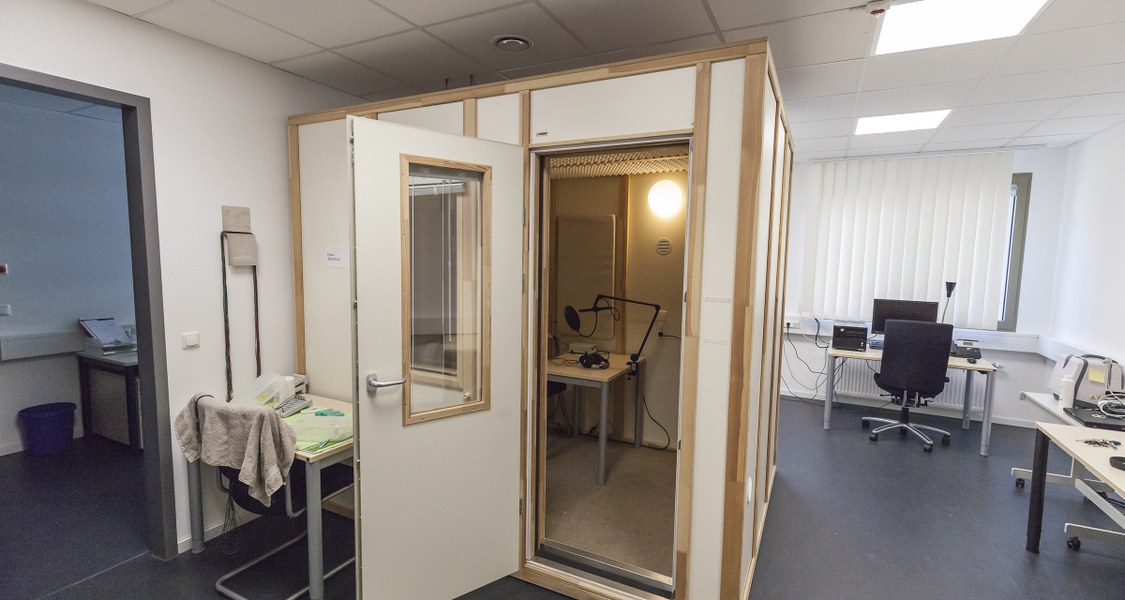Main Content
Neurolinguistics and Phonetics Laboratory Network

The Neurolinguistics and Phonetics working groups have jointly created a laboratory network that allows speech recordings, behavioral experiments, EEG and eye tracking studies to be carried out. The laboratories are supervised by Prof. Dr. Ulrike Domahs (Neurolinguistics) and Prof. Dr. Mathias Scharinger (Phonetics) and technically supported by Mr. Markus Jesberg.
- Lab manager: Markus Jesberg
- Database for those interested in participating in studies: Participant Database
Information for:
Students
The laboratories are available to students who would like to complete internships or their final theses in the research groups Neurolinguistics (Prof. Dr. Domahs) or Phonetics (Prof. Dr. Scharinger) and who are interested in conducting or supporting empirical studies themselves. For more information, see the „Studying“ pages for Neurolinguistics und Phonetics.
Participants
The research carried out in our laboratories has received a comprehensive laboratory vote from the ethics committee. Participation in our experiments using the methods described on this page is therefore safe from both a health and ethical point of view. Our staff and students are always on the lookout for test subjects for their research and final theses. If you are interested, please contact us or simply register in the The research carried out in our laboratories has received a comprehensive laboratory vote from the ethics committee. Participation in our experiments using the methods described on this page is therefore safe from both a health and ethical point of view. Our staff and students are always on the lookout for test subjects for their research and final theses. If you are interested, please contact us or simply register in the Participant Database.
Experimental Possibilities:
Behavioural Experiments/Reaction Time Studies
In both the phonetics and the EEG booths, a Reaction Time Box (RTBox) can be used to carry out behavioral experiments with reaction time measurement with an accuracy of a few milliseconds. It is controlled via MATLAB. The RTBox is connected to a recording computer via USB and, thanks to an integrated chip, can record up to 4 different responses that can be read out after the experiment. Experimental stimulation is carried out by means of free-field presentation (loudspeakers), high-quality headphones (BeyerDynamics DT 900) or, for visual stimuli, via a 24-inch monitor.
Online Experiments
Behavioral experiments and reaction time studies can also be conducted online using various experimental programs (e.g. OpenSesame, PsychoPy, Psychtoolbox). This allows for location-independent and time-flexible data collection.
EEG Experiments/Electrophysiological Studies

Foto: Mathias Scharinger
The neurolinguistics laboratory is equipped with a booth shielded from sound and electromagnetic waves used for EEG recording with a passive (BrainAmp) or active (ActiChamp) system. Passive and active EEG electrodes as well as passive electrodes for recording an electromyogram (EMG) are used for speech production studies in the neurolinguistics and phonetics laboratory network. The phonetics booth is also suitable for electrophysiological studies to be carried out. A BrainProducts amplifier (BrainAmp) with passive or active electrodes or the mobile LiveAmp system, which is equipped with a trigger extension (4-bit trigger channel), are used. The BrainAmp and ActiChamp amplifiers can be combined with 32 or 64 electrode caps (easy-CAP). The mobile LiveAmp system facilitates the conduction of field studies. The equipment of the two laboratories also allows parallel measurements.Speech Recordings/Production Studies
The phonetics booth contains a high-quality microphone that can be used for studio-quality voice recording. The entire audio infrastructure is organized via a Behringer 24-bit mixing console, which provides countless possibilities for mixing and recording. In addition, voice production experiments can be conducted in the phonetics booth. Measuring equipment for electromyography, pneumotachography, laryngography and ultrasound are also available.
Audiometry
The phonetics laboratory also offers the possibility for audiometry to be carried out. The measuring equipment can be borrowed from Markus Jesberg.
Eye Tracking

Foto: Frank Domahs
The phonetics laboratory is equipped with the EyeLink 1000 eye tracker from SR Research Ltd, an eye tracker with a head mount that allows monocular recording of eye movements with a resolution of up to 1000 Hz. Above that, the EyeLink 1000 can measure and record pupil responses (pupillometry).
Eye tracking studies can also be carried out with the mobile Tobii Pro Spectrum eye tracker. It measures binocular eye movements with a resolution of up to 300 Hz while the subject is sitting unrestrained in front of the monitor. This allows the Tobii Pro Spectrum eye tracker to be used for field studies.
Software:
Stimulation and Analysis Programs
The software applications MATLAB (including Psychtoolbox, fieldtrip, EEGLab, STRAIGHT, Psycho-Acoustics Toolbox, MIRToolbox), Octave, Python (in the Anaconda distribution), OpenSesame, EEProbe, PRAAT and Audacity are used for experimental stimulation and analysis of all kinds of empirical speech and neurophysiological data.